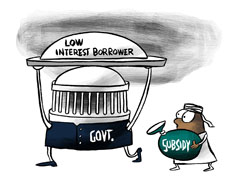Sir we took a sbi global Ed-vantage education loan with collateral for 80lakh on May 2024. For 10.65.%for 15yrs. They said int rates are computerized pan India. So we trusted them. But after one year nd disbursement of 40lakh . But we got email saying interest is now 11.15% we checked. current rates it was 9.15 .%. we were shocked it made as to check what was the rate during our loan sanction time. It was same 9.15. we felt cheated . When we asked the bank they said they can't change that. Let's see what can be done for 0.5%increase . Trusting sbi nd not checking the rates was our fault. Now what's the remedy for us. Hope you can guide us. We will be grateful for your help.
Ans: You’ve done the right thing by revisiting and questioning the loan terms. It’s understandable to feel disappointed and betrayed. Many borrowers assume public banks will offer full transparency. But sadly, loan processes — even in SBI — are not always straightforward. Let’s explore your case from all angles and suggest clear remedies.
1. Understanding the Real Issue First
Your SBI education loan was sanctioned at 10.65% in May 2024.
Today, after disbursing Rs. 40 lakh, you’ve been told the new rate is 11.15%.
But the current advertised rate is only 9.15%.
This mismatch raises a key concern: Was your rate fixed or floating?
SBI Global Ed-Vantage loans are generally linked to EBLR (External Benchmark Lending Rate).
That means the interest rate must change as the RBI repo rate changes.
But the reality is, SBI often adds a “spread” or “premium” over the benchmark rate.
This spread is based on credit score, collateral, student profile, etc.
Even if repo goes down, SBI may increase spread, keeping final rate high.
And sadly, banks don’t disclose this clearly unless you ask.
2. What Might Have Happened in Your Case
SBI’s base rate (EBLR) may have been 9.15% during sanction.
But your rate was 10.65%, which means spread was 1.50%.
Now, repo may have dropped, but SBI raised the spread silently to 2.00%.
So your new rate is 9.15% + 2.00% = 11.15%.
This is how banks play with the spread behind the scenes.
It’s not illegal. But it is misleading if not explained upfront.
3. Your Mistake Was Only Trusting Without Verifying
It’s true — not checking the benchmark and spread is common.
Many assume SBI will give best possible rate.
But banks use “pan-India computerized” explanation to avoid individual discussions.
Now that you caught it, it’s time to take the right steps.
4. What You Can Do Immediately
First, send an official written complaint to SBI branch manager.
Ask for detailed loan sanction letter, annexure, and EBLR-linked rate calculation.
Request a written breakup: current repo rate + spread = your interest.
Ask for justification of why spread is 2.00% now.
Mention the advertised rate (9.15%) and ask why you didn’t get it.
Submit this via email and hard copy and ask for written reply.
5. If Bank Doesn’t Cooperate, Escalate in Stages
After 7 working days, if branch doesn’t reply, write to SBI Zonal Office.
You can get email and contact on SBI website under grievance redressal.
Still no help? Raise complaint to SBI Customer Care portal online.
Use this link: https://crcf.sbi.co.in/ccf/
Clearly mention the unfair spread hike, deviation from base rate, and lack of clarity.
Upload all documents, email chains, and screenshots.
You will get a complaint ID. Follow it regularly.
6. If Still No Resolution – Use RBI Ombudsman Route
Wait for 30 days from SBI complaint.
If no response or unsatisfactory reply, file online to RBI Banking Ombudsman.
Use this link: https://cms.rbi.org.in
Fill full complaint history, and attach copies.
You can highlight that loan was linked to repo rate but you were charged more.
RBI may take strict action if SBI is found wrong.
7. Optional But Powerful – RTI Filing
You can also file RTI to SBI Head Office.
Ask:
What was EBLR in May 2024?
What is the spread for Global Ed-Vantage loans for a profile like yours?
Why your loan is now at 11.15% while base rate is 9.15%?
File online here: https://rtionline.gov.in
Cost is Rs. 10. Takes 5 minutes. Use your name and bank account number.
SBI must reply in 30 days.
8. What to Avoid Now
Do not make fresh disbursement of the remaining Rs. 40 lakh unless clarified.
Don’t blindly continue EMI or interest payments without documents.
Don’t fall into trap of “switch to fixed rate” offers from bank.
That can trap you at high rates even when repo falls later.
And don’t assume you can’t fight – RBI is serious about customer complaints.
9. Is Loan Takeover Possible from Another Bank?
After first disbursement, loan takeover is hard.
Very few banks take over mid-way student loans.
But if issue continues, and rate remains high, you may explore NBFC options later.
They may allow takeover if collateral is strong.
But this should be Plan B, not immediate action.
10. What Can You Learn and Apply Ahead?
Always ask for base rate + spread breakdown during loan sanction.
Ask if rate is repo-linked or MCLR-linked or fixed.
Collect the signed loan agreement and annexure with these details.
Ask for email confirmation, not just verbal words.
And monitor repo and EBLR changes every quarter.
11. Financial Tip: Start Small SIP for Education Loan Buffer
Start a monthly SIP to build buffer for future EMIs.
In case interest rate continues rising, this corpus can help.
Use short-term debt fund or ultra short-term fund for this.
This will reduce dependence on fresh disbursement or bank help.
Finally
You’ve taken a bold and right step by verifying everything.
SBI has no right to quietly raise spreads without proper explanation.
You can fight this legally and fairly through written complaints and RTI.
Be persistent, polite, and professional.
Track everything and escalate stage by stage.
Your case can also become reference for many other parents and students.
Take this fight not just for you, but for every Indian borrower.
Best Regards,
K. Ramalingam, MBA, CFP,
Chief Financial Planner,
www.holisticinvestment.in
https://www.youtube.com/@HolisticInvestment

























